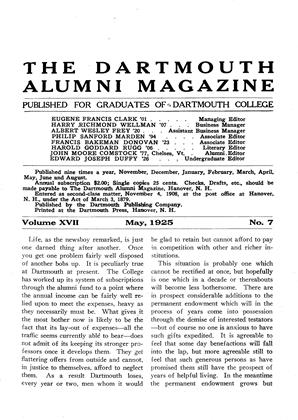The psychological examination given to the Dartmouth freshmen last fall was published by the American Council on Education "for official use in accredited colleges and universities." The use of this examination constitutes the moat extensive experiment so far undertaken for the standardization of mental measurement in colleges. The separate tests of which the examination consists are nine in number: (1) completion of definitions, (2) arithmetic problems, (3) artificial language, (4) proverb-matching, (S) comprehension of reading, (6) opposites, (7) grammar, (8) commonsense estimating, and (9) reasoning.
That psychological tests have a prognostic value in colleges has been variously demonstrated in many institutions. In our own class of 1924 67.5% of the men in the top psychological fifth graduated with their class, whereas only 27.9%' of those in the bottom fifth did so. The sectioning of large classes into groups homogeneous in ability has proved another prognostic utility of such tests.
The Department of English at Dartmouth sectioned the freshmen last fall on the basis of six of the nine tests in the psychological examination, as a trial of this method. No sectioning device which deals with so many variables as affect scholarship can be altogether infallible; but the use of mental scores is a means available a very few days after college opens, and certainly has admitted superiority over such chance devices as alphabetical division.
The designers of psychological examinations have entertained hope that such examinations might have, in addition to the general prognostic value, some diagnostic value: that the separate test scores could be used to aid in the problems of educational guidance, or perhaps even of vocational guidancet Up to the present this hope has not materialized; but with such organizations as the National Research Council definitely countenancing these problems, the hope of diagnostic tests need not be lost.
So much interest has been manifested in the psychological examination given to the present freshman class that it seems desirable to make public some of the salient facts with regard both to the prognostic and to the diagnostic results of the tests.
Of 38 freshmen achieving a total scholastic average of 3.0 or better 24 were in the top psychological tenth, 29 were in the top fifth, and only 8 were not in the top quarter.
Of 58 freshmen falling below an average of 1.0, 20 were in the bottom psychological tenth, 28 were in the bottom fifth, and only 8 were not in the bottom half.
The separate tests which most distinguished this superior scholarship group from the inferior group are the completion and artificial language tests. The tests which least distinguished the two scholarship groups are the estimating, proverbs, and reasoning tests.
In Latin and 7 the most diagnostic test is the arithmetic test, followed, in order, by artificial language and reasoning. In Greek no test is diagnostic—a fact due largely to the small number of cases. In French 5 and 11 the grammar and opposite tests are most diagnostic; in Spanish and 11, the grammar and artificial language tests. In English, opposites, completion and grammar are the most diagnostic tests.
The following tables show, first the aver- age percentile in each test for the superior and inferior scholarship groups; and second, the average percentile in each test for A and E men in English: Total Scholarship S I Reading 82.9 36.7 Proverbs 71.6 34.8 Opposites 81.3 35.1 Completion 77.9 29.5 Grammar 77.2 33.3 Art. Lang 84.4 31.7 Reasoning 75.2 38.2 Arithmetic 77.4 34.9 Estimating 65.1 42.1 Total Exam 87.5 26.7 English A E Reading 81.1 34.1 Proverbs 77.0 28.9 Opposites 88.9 27.3 Completion 90.5 30.1 Grammar 82.4 27.0 Art. Lang 84.6 33.2 Reasoning 70.9 37.4 Arithmetic 66-4 Estimating 76.1 43.8 Total Exam 88.6 24.3
In general, it should be noted that the total examination is a better indicator of the scholarship to be expected in any subject than any one of the component tests; and that the total test correlates better with total scholarship than it does with scholarship in any one subject. In other words, the prognostic value is established; the diagnostic value is a matter for future research.
 View Full Issue
View Full Issue
More From This Issue
-
 Article
ArticleTHE COLLEGE AND PHYSICAL FITNESS*
May 1925 By WM. R. P. EMERSON, M. D. -
 Article
ArticleA CRITIQUE OF "THE LIBERAL COLLEGE"
May 1925 -
 Article
ArticleWHEN THE KING OF FRANCE CAME TO DARTMOUTH
May 1925 By Eric P. Kelly 1906 -
 Article
ArticleLife, as the newsboy remarked
May 1925 -
 Class Notes
Class NotesCLASS OF 1917
May 1925 By Ralph Sanborn -
 Article
ArticleThe Attitude Unworthy
May 1925








